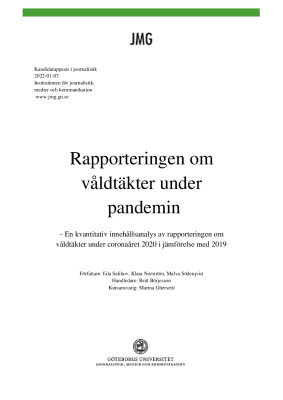Rapporteringen om våldtäkter under pandemin
– En kvantitativ innehållsanalys av rapporteringen om
våldtäkter under coronaåret 2020 i jämförelse med 2019
In 2020, when the corona pandemic swept across the world, restrictions were introduced that regulated the way people socialized. Some of the regulations were that night clubs closed, festivals and concerts were canceled or rescheduled. People were recommended to mostly work and study from home to reduce the spread of the coronavirus. The following are the main questions addressed in this thesis: What does the reporting on rape look like during the
pandemic in 2020 in the following newspapers: Aftonbladet, Dagens Nyheter and Expressen?
How does rape reporting in 2020 differ from the year before in 2019? How does the news reporting reflect the crime statistics for 2020 compared to 2019? This is what this study aims to find out.
Our theoretical framework is built on the agenda setting theory, media logic about news
values and the selection of the news, and the Swedish media ethics of journalism.
The methodology we used was a quantitative content analysis of articles in the newspapers
Aftonbladet, Expressen and Dagens Nyheter. We analyzed a total of 788 articles about rape,
based on our selection in searchfield. Our code scheme with 51 variables asked different
questions about the texts and their images.
We found a total of 345 articles about rape in 2020, compared to 443 articles in 2019, which
means that fewer articles were published in the form of rape reporting in the analyzed media in 2020 compared with the year before, 2019. In statistics about reported rapes from 2019 and 2020, we found that the same amount of rapes were reported against women aged 18 or older during both years. That means that news reporting about rape differ between the years, even though the same amount of rapes were reported. The news reporting in the studied
newspapers corresponds to the crime statistics for some of the variables we have chosen to investigate. Though some are not consistent with the statistics, for instance the place of the rape and relationships between the perpetrator and victims. The result of this study is that the analyzed newspapers do not report about rape in a way that reflect the crime statistics.

